 Bomber Command
Bomber Command  |
Aircrew Chronicles
|
Aircrew Losses
|
Nose Art
|
BCATP
|
Lancaster
|
Media
|
Aircrew Chronicles
|
Aircrew Losses
|
Nose Art
|
BCATP
|
Lancaster
|
Media
 Bomber Command
Bomber Command  |
Aircrew Chronicles
|
Aircrew Losses
|
Nose Art
|
BCATP
|
Lancaster
|
Media
|
Aircrew Chronicles
|
Aircrew Losses
|
Nose Art
|
BCATP
|
Lancaster
|
Media
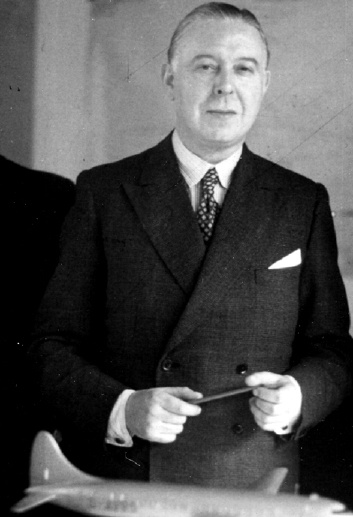 |
"Architect of Wings" by Harald Penrose includes a tribute from Marshall of the Royal Air Force Sir Arthur Harris, the famous wartime chief of Bomber Command. It had been taken from a letter written to Chadwick's daughter Margaret and read, "Your father never received a tithe of the recognition and honours due from the nation for his services. The Lancaster took the major part in winning the war with its attacks on Germany. On land it forced the Germans to retrieve from their armies half their sorely needed anti-tank guns for use as anti-aircraft guns by over a million soldiers who would otherwise have been serving in the field. The Lancaster won the naval war by destroying over one-third of the German submarines in their ports, together with hundreds of small naval craft and six of their largest warships. Above all, the Lancaster won the air war by taking the major part in forcing Germany to concentrate on building and using fighters to defend the Fatherland, thereby depriving their armies of essential air and particularly bomber support. But the Lancaster was Roy Chadwick, and it was he who did all that for his country."
|
Through the book and this quote, our museum became aware of the significance of the Lancaster and the potential the "Nanton Bomber" had to help tell the story of Bomber Command and as well, to tell the story of its designer. The following year, Roy Chadwick's daughter, Margaret Dove, was invited to become the Society's Honourary President. We were delighted by her acceptance and she fulfilled this role for twenty-one years. Following her death in 2008, Don Hudson, Roy Chadwick's nephew, took over the role. Margaret sent us numerous letters and photographs and documents that pertain to her father's career. As well, she has provided several taped messages for our annual special events. Most importantly, Margaret has offered encouragement, inspiration, and appreciation to the museum's volunteers. Margaret is the author of the following article titled, "Father of the Lancaster." It was first published in "Wingspan International" in November 2003. |
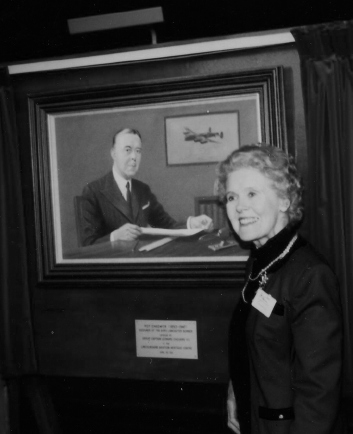 of a painting of her father at the Aviation Heritage Centre at East Kerkby in 1990. |
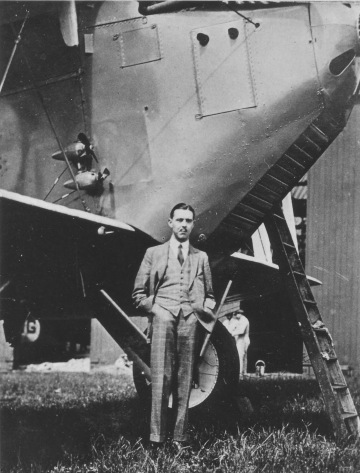 |
My father was a Lancastrian and very proud of this. The name Chadwick is a familiar one in the Manchester area. Roy's father, grandfather, great-grandfather, and great-great-grandfather had all been engineers on various projects over the years so it was not surprising that Roy followed in that profession. His father, Charles, had been apprenticed to the United Alkali Company as a mechanical engineer and later moved to British Westinghouse as head of the foreign apprentices department. Roy was born on April 30, 1893, and attended St. Clement's School where he became interested in the new art of powered flight. His heroes were all the early aviation pioneers. Roy began to make model aircraft, his mother helping by stitching silk from blouses to cover the wings and fuselages. At the age of fourteen, Roy joined British Westinghouse to train as a draughtsman in the drawing office under George Bailey. At the same time he began to attend evening classes three times a week where he studied pure and applied mathematics, mechanical engineering and other allied subjects. At the end of his apprenticeship, Roy wanted to pursue a career in aviation. He applied for an interview with A.V. Roe, who engaged him as his personal assistant in the fledgling firm of A.V. Roe and Co. in Brownsfield Mill, Ancoats, Manchester. Alliot Roe and Chadwick got on extremely well. The older man took Roy under his wing, give him ideas to draught and presentations to make to the Admiralty. In the early years he was like a father to Roy. |
Under A.V. Roe's inspired leadership, Roy Chadwick took a major part in the design of Avro aeroplanes during the First World War. He told me he was personally involved in the Friedrichshafen raid and that, at 21 years of age in 1914, he had 100 men under him to whom he had to impart all the knowledge he had learnt.
When Roe built the Experimental Works at Hamble in 1916, Roy went down and was in charge with Reginald Parrott. As the war ended, my father became Avro's chief designer, officially. He designed over 200 aeroplanes, 35 of which became production models. The Avro 540K was an RAF trainer and later gave many thousands their first flights. My father collaborated with the inventor Senor Juan de la Cierva to mount his autogiro rotors upon a 504K fuselage.
In 1921 Roy had a near fatal crash on his Avro Baby, the world's first true light aeroplane. He crashed into trees surrounding the Rev. Everage Verdon-Roe's vicarage at Hamble. After extensive surgery, Roy recovered from his injuries. He designed the "Antarctic" for Sir Ernest Shackleton's 1921 expedition; the "Aldershot," the world's largest, single-engined bomber; the "Ava" torpedo bomber; the "Andover;" the "Avis;" the "Avenger" all-metal fighter, and the "Avian."
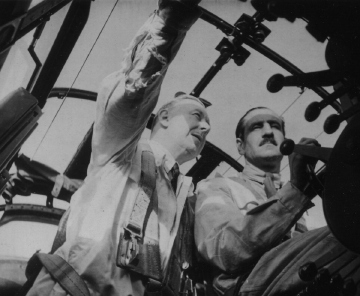 Roy Cadwick (left) and test pilot Bill Thorn in a Lancaster Cockpit [1942]. |
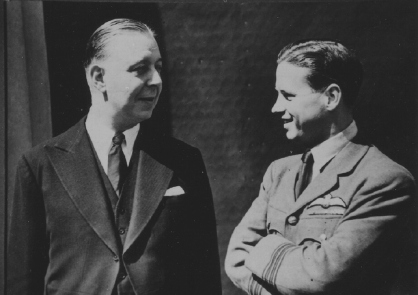 Roy Chadwick (left) with Guy Gibson. |
In 1923 Roy Chadwick married Mary Gomersall who was from an old Yorkshire family. She had her first flight in an Avro Avian with Bert Hinkler as pilot. It was in 1928 that Hinkler made a record solo flight of fifteen and one half days to Australia in his own Avian.
Back in Manchester in 1928, the design team headed by Chadwick produced the Avro ten passenger aircraft with a welded-steel tube fuselage. Australian pioneers Charles Kingsford Smith and Charles Ulm bought several for their airline, Australian National Airways Ltd. Two variants followed and then the Avro Tutor emerged and replaced the 540K as the standard RAF trainer.
In 1933, Imperial Airways ordered the four-passenger monoplane Chadwick had designed, the Avro Anson. Shortly afterwards, this aeroplane matched government requirements for coastal reconnaissance work and nearly 11,000 Ansons were ultimately built.
As war loomed, Roy Chadwick designed the Manchester twin-engined bomber and laid down a four-engined version. Immensely strong, the Manchester was powered, because of wartime shortages, by the untried Rolls-Royce Vulture engine which proved unreliable. A Ministry official told me Chadwick showed them how he could lengthen the Manchester wing and install four Rolls-Royce Merlin engines and in January 1941 the Lancaster was born.
Totally committed during the war, Roy would often visit two nearby Avro factories en route to the office, direct his staff of over 250 draughtsmen and tracers, and visit the Air Ministry and various RAF stations. Each night he would drive over twenty miles home to the family he loved -in winter, through black-out and fog. Then he often designed into the early hours. The Lincoln, York, and Lancastrian, modifications to the Lancaster for special roles, flowed from his drawing board.
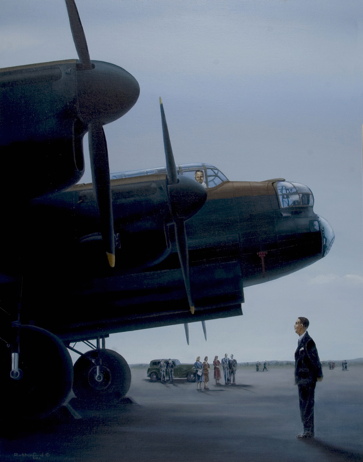 depicting Roy Chadwick at the first flight of the Lancaster. |
In 1943, my father was honoured with the CBE after the Dambuster Raid. He had worked closely with Dr. (later Sir) Barnes Wallis redesigning the Lancaster bomb bay to take the Wallis mine (the weapon used by the Dambusters). Also Britain's first pressurized, trans-Atlantic passenger aircraft, the Tudor, was designed in 1943. Anxious that Britain should match the USA in post-war aviation, Chadwick flew to America in November 1943, visiting Avro Canada and the Lockheed and Boeing companies. In the winter of 1945/46 I remember my father telling us they had named his coastal reconnaissance machine the Shackleton. This famous long-lived aeroplane was in the mock-up stage when he died. The City of London made Roy Chadwick an Honourary Freeman of the City and Manchester University and Technical College also honoured him. His last thoughts on aviation were to spearhead the RAF Bomber Command for over a quarter of a century. During Christmas 1946/47, he sat and schemed the brilliant delta wing which became the Vulcan. In July 1947, as the Ministry were preparing to approve the Vulcan tender, my father enjoyed a brief, delightful business visit to the Isle of Harris. Then at 11:00 hrs on August 23, 1947, after a servicing error the previous night, the Avro Tudor II with Roy Chadwick aboard crashed just after take-off on a test flight. He was killed. In the words of the Rubaiyat, which he often used to quote, "Fate turned down an empty glass where had been his honoured life." |
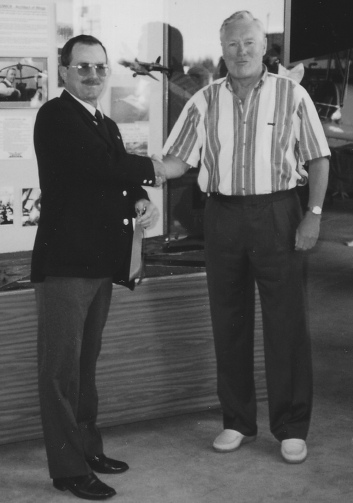 with Don Hudson at the opening of a display honouring Roy Chadwick. |
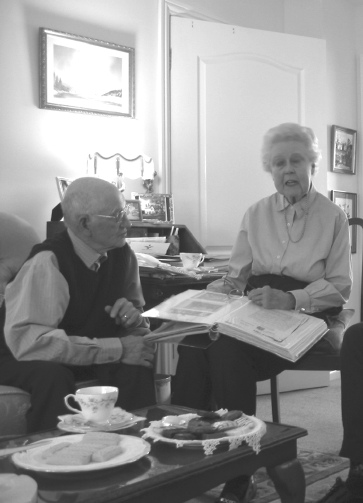 having tea with Margaret Dove on the Isle of Mann. |